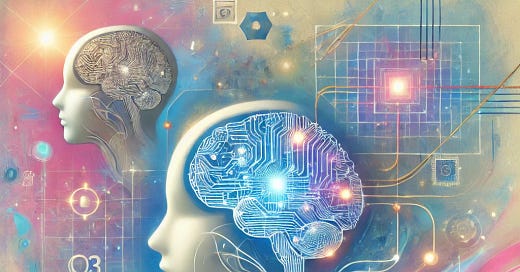OpenAI's o3 and o3 Mini Models: A Paradigm Shift in AI
Our unique perspectives explore the implications for India, spanning both governmental and corporate sectors.
OpenAI's o3 and o3 Mini Models
OpenAI's unveiling of the o3 and o3 Mini models marks a transformative leap in artificial intelligence, poised to redefine the boundaries of AI research and applications. Announced during the "12 Days of OpenAI" event on December 20, 2024, these models introduce groundbreaking capabilities that could reshape industries and academic fields alike.
The Announcement: A New Chapter in AI
CEO Sam Altman introduced the o3 and o3 Mini models as successors to the o1 model, which debuted in September 2024. Skipping the "o2" designation—a move reportedly made to avoid copyright conflicts with the British telecommunications company O2—OpenAI’s o3 models signal a bold step forward. Designed to excel in complex reasoning tasks across diverse domains such as mathematics, programming, and scientific problem-solving, these models are a testament to AI’s evolving potential.
Our honorary Tech Advisor, Bilawal Sidhu, based in Austin, Texas, tweeted barely one hour ago: “It’s not a bubble. Buy Nvidia,” highlighting the surging demand for Nvidia's GPUs, which are indispensable for powering such computationally intensive AI systems.
Unveiling the o3’s Pioneering Features
Performance Benchmarks: Breaking Records
The o3 model has achieved unprecedented performance metrics, including:
Mathematics: Scoring 96.7% accuracy on the American Invitational Mathematics Examination (AIME) 2024.
Programming: Outperforming OpenAI’s Chief Scientist on the Codeforces platform with a score of 2727.
Scientific Reasoning: Achieving 87.7% on the GPQA Diamond benchmark for PhD-level queries.
ARC-AGI Challenge: Leaping from a 5% score at the beginning of the year to an impressive 88%.
Advanced Reasoning: Human-Like Problem-Solving
The o3 model pioneers deep learning-guided program synthesis, enabling dynamic generation and testing of programs to solve complex problems. This represents a shift from static output generation to active, iterative problem-solving—an approach that closely mirrors human cognitive processes.
Transforming Search and Computing Paradigms
Enhanced Problem-Solving
The o3’s sophisticated reasoning capabilities promise to revolutionize search engines by delivering highly accurate, context-rich results. This could fundamentally alter how users access and interpret information.
Accelerating AI Research
The rapid evolution from o1 to o3 within just three months underscores a significant acceleration in AI development. This pace suggests potential breakthroughs across scientific, industrial, and educational fields.
Automating Complex Tasks
With its ability to tackle intricate challenges in software engineering, data analysis, and scientific research, the o3 model could automate tasks that traditionally required extensive human expertise.
Balancing Costs and Benefits
High Computational Costs
While the o3’s capabilities are groundbreaking, its computational requirements remain a significant barrier. For example, solving 400 ARC-AGI puzzles in high-efficiency mode costs $6,677, with the highest possible computational costs reaching $1.14 million for similar tasks.
Given the cost of a query, framing the right type of questions becomes critically important. Users must avoid using the model as a "sledgehammer to kill a fly" and instead focus on precision—asking the right question is akin to making the perfect wish from a magic genie. This precision not only optimizes the use of the model but also ensures cost-effectiveness.
Transformative Benefits
Despite these costs, the o3 model offers:
Advanced Problem-Solving: Enabling breakthroughs in mathematics, coding, and science.
Improved Efficiency: Reducing the time and resources needed for complex analyses.
Economic Growth: Opening new avenues for AI-powered industries and innovation.
Our Perspectives on Potential Uses
Even with high costs, the o3 model’s value is undeniable in high-stakes scenarios. For instance, comparing it to a research team that might take six months to deliver a solution, the model provides answers within tight and immutable timelines, which is critical in corporate or governmental decision-making where implications run into billions of dollars. In such cases, even a cost that is 100 times higher than traditional methods may be justifiable for the speed and precision it offers, if the answer is required, say overnight.
Although this technology may not be democratized in the immediate future, advancements in algorithms and learning processes could help reduce costs significantly over time. As the model learns to refine and eliminate less optimal solutions, the cost per query may decrease substantially, if not dramatically, making it more accessible in the long run.
Implications for India: Opportunities and Challenges
Academic and Research Institutions
Collaborative Opportunities: Partnerships with OpenAI could provide Indian institutions access to cutting-edge AI resources.
Skill Development: A growing demand for AI specialists highlights the need for updated educational curricula.
Research Acceleration: Leveraging o3’s capabilities could propel Indian research in fields like genomics, quantum computing, and climate science.
Government Initiatives
Policy Formulation: Advanced AI necessitates robust policies to address ethical, economic, and regulatory challenges.
E-Governance: Integrating o3 into governance could enhance efficiency in service delivery.
Economic Strategy: Policymakers must anticipate AI’s impact on job markets and industrial dynamics.
Digital India Initiative: The o3’s potential aligns with India’s digital transformation goals, offering sophisticated tools for data-driven governance.
Conclusion: The Road Ahead
The o3 model stands as a beacon of AI’s future, demonstrating unprecedented reasoning capabilities and transformative potential. However, its high computational costs present challenges that must be addressed for broader adoption. For India, the o3 represents both an opportunity to lead in AI innovation and a challenge to navigate the socio-economic shifts it may bring. As the world embraces this new era, the balance between leveraging AI’s benefits and mitigating its risks will define the path forward.




